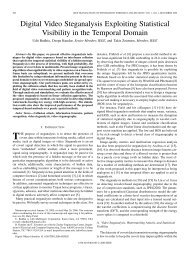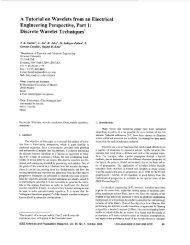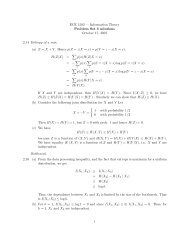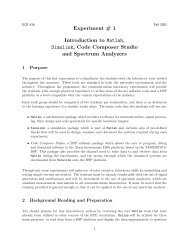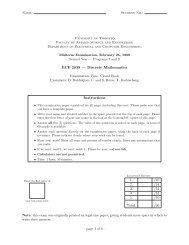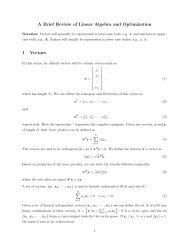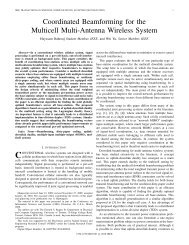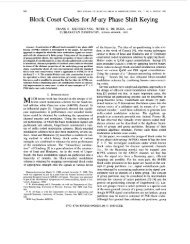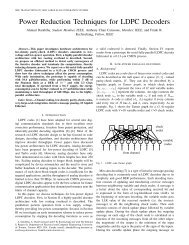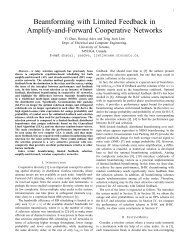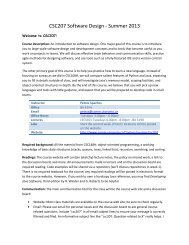The Gram-Schmidt Procedure and Orthogonal Projections 1 ...
The Gram-Schmidt Procedure and Orthogonal Projections 1 ...
The Gram-Schmidt Procedure and Orthogonal Projections 1 ...
You also want an ePaper? Increase the reach of your titles
YUMPU automatically turns print PDFs into web optimized ePapers that Google loves.
Show that proj v (u) is the orthogonal projection of the vector u on the linear subspace spannedby the vector v. (Hint: show that the “error” u − proj v (u) is orthogonal to v, <strong>and</strong> hence isorthogonal to every vector in the linear subspace spanned by v.)In Matlab or Octave, the inner product between vectors u <strong>and</strong> v can be computed usingdot(u, v). Write a function (saving it in the file ‘PROJ.m’)function w = PROJ(u,v)that implements the projection operator proj v . (Caution: in Matlab, dot works correctlyfor real-valued <strong>and</strong> for complex-valued vectors, but in Octave, dot is incorrectly implementedfor complex-valued vectors. Throughout this lab, we will only use real-valuedvectors in R n .)Test that your function PROJ works correctly by computing the following projections:PROJ([1 2 3],[1 1 1]) =PROJ([1 2 3],[0 0 0]) =PROJ([1 2 3],[1 1 -1]) =<strong>The</strong> <strong>Gram</strong>-<strong>Schmidt</strong> procedure takes in a finite set of vectors {v 1 , . . . , v n } (not all ⃗0) in aninner-product space V <strong>and</strong> produces an orthonormal set {w 1 , . . . , w m }, m ≤ n, such thatL({w 1 , . . . , w m }) = L({v 1 , . . . , v n }), where L(·) denotes the linear span, i.e., the subspaceobtained from all possible linear combinations of the elements of the corresponding set.In a “naive” implementation, the <strong>Gram</strong>-<strong>Schmidt</strong> procedure would compute as follows(keeping only the nonzero w i ’s that are produced):u 1 = v 1 w 1 = u 1 /‖u 1 ‖ (or ⃗0 if u 1 = ⃗0)u 2 = v 2 − proj w1(v 2 ) w 2 = u 2 /‖u 2 ‖ (or ⃗0 if u 2 = ⃗0)u 3 = v 3 − proj w1(v 3 ) − proj w2(v 3 ) w 3 = u 3 /‖u 3 ‖ (or ⃗0 if u 3 = ⃗0).u i = v i − ∑ i−1k=1 proj w k(v i ) w i = u i /‖u i ‖.(or ⃗0 if u i = ⃗0)2
Write a function (saving it in the file ‘NAIVEGS.m’)function w = NAIVEGS(v)that implements the naive <strong>Gram</strong>-<strong>Schmidt</strong> procedure. <strong>The</strong> argument to the function is ann × l matrix v whose rows are vectors in R l . <strong>The</strong> output is an m × l matrix w whose rowsare the desired orthonormal basis.Programming notes (in Matlab or Octave):1. <strong>The</strong> number of rows of a matrix v can be obtained as size(v,1).2. <strong>The</strong> ith row of a matrix v can be addressed as v(i, :).3. <strong>The</strong> function zeros(size(x)) returns an all-zero array with the same shape asthat of x.4. A row can be appended to a matrix simply by assigning to it, e.g.,w(i,:)= u(j,:)assigns the jth row of u to the ith row of w.Test your function by computing the following.A = NAIVEGS([1 1; 1 0])B = NAIVEGS([0 0 0 0 ; 1 1 1 1])C = NAIVEGS([1 1 1 1; 1 1 0 0 ; 1 0 1 0; 1 0 0 0 ])To verify that the resulting basis is in fact orthonormal, compute the inner product of eachrow of the basis with every other row of the basis. This is conveniently done in Matlab orOctave by computing, say, C ∗ C ′ where C is a basis matrix. (Here C ′ denotes the transposeof the matrix C.)If C is an m × l matrix whose rows form an orthonormal basis, what matrix shouldresult from the computation C ∗ C ′ ?3
Unfortunately, the naive <strong>Gram</strong>-<strong>Schmidt</strong> procedure is numerically unstable, which meansthat it is highly sensitive to numerical errors. For example, try running NAIVEGS on the7th order Hilbert matrix:H7 = [ 1/1 1/2 1/3 1/4 1/5 1/6 1/7;1/2 1/3 1/4 1/5 1/6 1/7 1/8;1/3 1/4 1/5 1/6 1/7 1/8 1/9;1/4 1/5 1/6 1/7 1/8 1/9 1/10;1/5 1/6 1/7 1/8 1/9 1/10 1/11;1/6 1/7 1/8 1/9 1/10 1/11 1/12;1/7 1/8 1/9 1/10 1/11 1/12 1/13 ];C = NAIVEGS(H7);Z = abs(C * C’ - eye(7))In this computation, eye(7) denotes the 7 × 7 identity matrix, <strong>and</strong> abs computes theabsolute value of each matrix component.Ideally, what should Z be?What is the actual largest entry in Z?Fortunately, the <strong>Gram</strong>-<strong>Schmidt</strong> procedure can be made numerically stable via a simplemodification. Instead of computing∑i−1u i = v i − proj wk(v i )as in the naive <strong>Gram</strong>-<strong>Schmidt</strong> algorithm, compute u i in a series of steps:k=1u (1)i = v i − proj w1(v i )u (2)i = u (1)i − proj w2(u (1)i )u (3)i = u (2)i − proj w3(u (2)i ). .u i = u (i−2)i − proj wi−1(u (i−2)i )Copy your file NAIVEGS.m to the file GS.m <strong>and</strong> modify GS.m to implement the modified<strong>Gram</strong>-<strong>Schmidt</strong> procedure as the functionfunction w = GS(v)4
Using your new modified GS procedure, try running:D = GS(H7);Z = abs(D * D’ - eye(7))Now what is the largest entry in Z?3 <strong>Orthogonal</strong> <strong>Projections</strong>Let P be a finite-dimensional subspace of an inner-product space V . Once an orthonormalbasis {w 1 , w 2 , . . . , w m } for P is obtained, the orthogonal projection of an arbitrary vectorv ∈ V on P is easily computed asˆv =m∑〈v, w i 〉w i .i=1<strong>The</strong> vector ˆv is the orthogonal projection of v on P <strong>and</strong> the components of the m-tuple(〈v, w 1 〉, 〈v, w 2 〉, . . . , 〈v, w m 〉)are the coordinates of ˆv with respect to the given orthonormal basis.Let B be an m × l matrix whose rows form an orthonormal basis for subspace P . (Forexample, B might be produced by your GS function.) Let v be an arbitrary 1 × l rowvector, <strong>and</strong> let ˆv be the orthogonal projection of v on P .• Give a Matlab or Octave expression (in terms of B <strong>and</strong> v) for the coordinatesof ˆv with respect to basis given in the rows of B.• Give a Matlab or Octave expression (in terms of B <strong>and</strong> v) for ˆv.5
For example, let P be the subspace of R 3 consisting of all vectors (x, y, z) with theproperty that x + y + z = 0. Find an orthonormal basis for P <strong>and</strong> compute theorthogonal projection of the following vectors on P .• v = [1,2,3], ˆv =• v = [1,1,1], ˆv =• v = [0,1,0], ˆv =In the above computations, let e denote the “error vector” v − ˆv. Compute 〈v, v〉, 〈ˆv, ˆv〉<strong>and</strong> 〈e, e〉 for the three cases above.Write a general relationship among the three quantities 〈v, v〉, 〈ˆv, ˆv〉 <strong>and</strong> 〈e, e〉, wheree = v − ˆv.4 <strong>The</strong> QR DecompositionLet V be a square matrix (assumed invertible) <strong>and</strong> let Q = GS(V) be the orthogonal matrixreturned by your <strong>Gram</strong>-<strong>Schmidt</strong> procedure. Each row of V has a set of coordinates withrespect to the rows of Q. This implies thatfor some matrix R.V = RQ,After trying a few examples, explain what special property the matrix R has.r<strong>and</strong>om n × n matrix can be obtained in Matlab or Octave via r<strong>and</strong>(n, n).A6
In linear algebra, this decomposition is usually written in transposed form, expressing aninvertible matrix V as V = QR where Q is an orthogonal matrix <strong>and</strong> R has a similar specialproperty as above. Such a decomposition is referred to as the “QR” decomposition.Thus we see that the <strong>Gram</strong>-<strong>Schmidt</strong> procedure results in a QR decomposition. By typing’help qr’, investigate whether your version of Matlab or Octave implements the QRdecomposition.5 Approximate Curve FittingConsider the approximation of a function f(x) over the interval [0, 1] as a quadratic polynomial.Here we show how this can be done approximately using orthogonal projections.In Matlab or Octave, run the following:N = 9;a = linspace(0,1,N);v(1,:) = ones(size(a));v(2,:) = a;v(3,:) = a .* a;b = GS(v);<strong>The</strong> linspace(a,b,N) function returns a vector of length N with samples uniformlyspaced from a to b, inclusive. <strong>The</strong> ‘.*’ operator takes the componentwise product of thecorresponding vectors.<strong>The</strong> matrix v now contains three rows: the first row contains samples from the constantfunction; the second row contains samples from a linearly increasing function; <strong>and</strong> thethird row contains samples from a quadratically increasing function.<strong>The</strong> matrix b contains a corresponding orthonormal basis. To see the corresponding samples,try the following comm<strong>and</strong>:plot(b(1,:)); hold; plot(b(2,:)); plot(b(3,:));Let us populate a vector f with samples from some function, e.g.,f = exp(a);Let g denote the orthogonal projection of f on the space spanned by the rows of v or b.Both f <strong>and</strong> g can be plotted as follows:7
hold off; plot(f); hold; plot(g);Express g as a linear combination of the rows of v. (N.B.: we are not asking for thecoordinates of g with respect to the orthonormal basis, but rather with respect to theoriginal basis.)A more accurate representation can be obtained by increasing the number of samples.Repeat this exercise for N = 100.When N = 100, the coordinates of g with respect to the rows of v are:8



